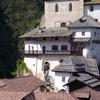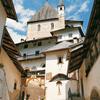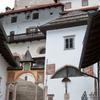Sanctuary of Saint Romedius
San Romedio. A thousand years of history, art and worship

Between 2012 and 2016, through its Cultural Heritage Department and following a memorandum of understanding stipulated with the Archdiocese of Trento and local authorities, the Autonomous Province of Trento authorised and funded important restoration work to safeguard and enhance the sanctuary of San Romedio. This included consolidation of the walls and plaster, refurbishment of the roof and restoration of pictorial decorations and stone elements such as the altars and group sculptures. Finally, it promoted the restoration of seventy votive tablets, among the 120 declared to be of cultural interest following careful cataloguing. On conclusion of the major conservation and improvement work to restore this extraordinary monument to history, art, faith and popular worship, a series of exhibition spaces were planned and set up in three rooms on the ground fl oor. Here it was intended to present the fi gure of Romedius, half-way between history and legend, illustrate the iconography of the sanctuary, raise awareness of a number of archaeological findings made at the foot of the cliff and highlight a selection of votive offerings, as well as the fresco decorations detached in 1932 and applied to canvas. A permanent exhibition has been created to recount the historic, artistic, iconographic, religious and devotional features of one of the most interesting sanctuaries in the alpine region.
The Sanctuary
The intricate structure of the monumental complex is the result of the addition of various sacred and secular buildings erected in different eras, starting from the oldest nucleus (11th-13th C) – which includes the shrine containing the relics and the chapel of San Nicolò – built at the top of a rocky limestone spur, up to the chapel of Our Lady of Sorrows, renovated in 1923. In 1487 the Cles family had the chapel of San Giorgio built, while the Thun family, who
were patrons of the sanctuary for three and a half centuries (1514 -1865), promoted the construction of the church of San Michele Arcangelo (1514- 1516) and the main church (1536). Other living and service areas, including the entrance stairway in the upper part of the sanctuary and the loggia around two sides of the internal courtyard, were added or extended in the 17th and 18th centuries.
In 1948 spiritual care of the sanctuary was entrusted to the Franciscan order, then passing to the order of the Friars Minor.
Saint Romedius
According to medieval biographies of saints, on his return from a pilgrimage to Rome around the end of the 4th century AD, the nobleman Romedius, originally from Thaur in the Inn valley, decided to withdraw to a cave and live as a hermit in the Val di Non area, in an inaccessible valley a short distance from Sanzeno, together with his companions Abraham and David. In actual fact, as historic and archive investigations have shown, the existence of the hermit, a member of an aristocratic Bavarian family, can be dated to the first decades of the 11th century. The first certain news of the cult – which extended from the Prince Bishopric of Trento right up to Austria and Bohemia – dates back to the end of the 11th century, the era in which the sanctuary was founded above a small cave, the place where Romedius lived and was buried.
Source: leaflet by the Department for Cultural Heritage of Trento




